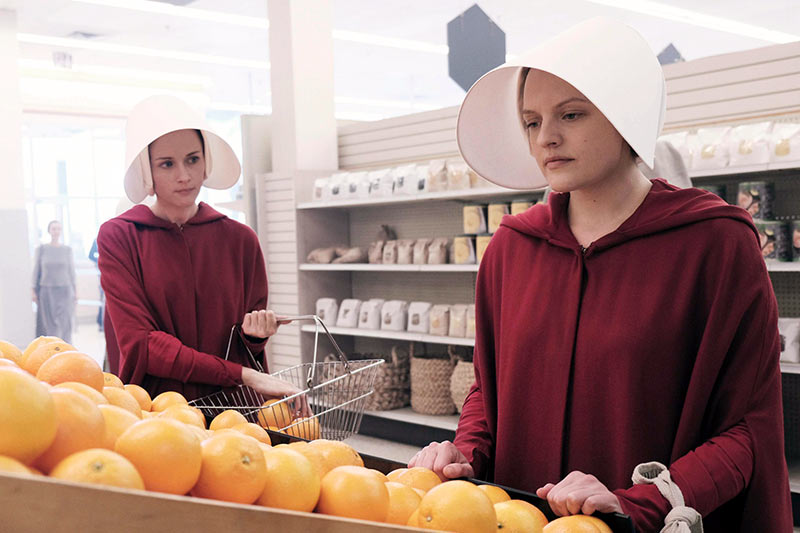Miguel Crespo
In late 2016, the streaming service Hulu produced a series of ten episodes based on the novel The Handmaid’s Tale, by the Canadian author Margaret Atwood. The first three episodes dropped on April 26, 2017 and scored the biggest debut in Hulu history. In May this year, the show was renewed for a second season to premiere in 2018. There have been numerous adaptations since the book was published: theater, opera, ballet, film, and radio. A graphic novel release is also scheduled by the end of the year. Given the recent interest in The Handmaid’s Tale, now is the perfect time to revisit the 1985 dystopian novel.
The story takes place in Gilead, a society organized by power-hungry leaders, according to a not-so-extremist interpretation of a biblical account. The story that was originally used as a reference was that of Jacob, who had two wives and two handmaids. In an era of declining births due to chemical pollution and sexually transmitted diseases, a new order is established where certain women are used as “handmaids”. Deprived of all of their rights, handmaids are considered objects destined to serve as child bearers for affluent families. The story is narrated in the first person by a handmaid named Offred. Interspersed within flashbacks, she provides an account of her previous life. Together with her husband and daughter, she had tried to flee to Canada, only to be abducted, brought back, and re-educated in the new values. An entire indoctrination system is revealed to the reader: the Republic of Gilead. This new society is stratified such that everybody has a well-defined position and function. As a patriarchal system, power is held by older men called commanders. They are married to wives but have the privilege of owning a handmaid for reproductive purposes. In this oppressive atmosphere, strict rules on language, daily activities, and ultimately thought are reinforced by a secret service known as The Eyes of God. One night, Offred defies the system and becomes involved in illicit activities that bring an element of risk to her life.
Offred’s story falls into the tradition of dystopian novels like Brave New World or 1984. As such, the author creates a unique language in which terms for the new social classes abound. The word “sterile” is banned, and women who fail to abide by the strict social rules are considered “unwomen” and sent to shovel toxic waste in the colonies. Throughout the story, the author also plays with the mock Latin aphorism nolite te bastardes carborundorum in a recurrent and intriguing fashion; readers have a chance to team up with Offred to try to unravel its meaning. The Handmaid’s Tale remains hard to classify. Deemed a futuristic fable, political satire, or even science fiction, Atwood prefers to consider her novel speculative fiction. In her own words, “science fiction has monsters and spaceships; speculative fiction could really happen.” When crafting the story, Atwood purposely avoided including anything in the book that had not happened.
Like Offred and her family, Americans fleeing their own land for the neighbor to the north has become a common theme in history. During the Vietnam War, thousands of draft-age men fled to Canada. Before the Civil War, many slaves reached southern Ontario through the underground railway. Even earlier, New England Puritans left for a toilsome life in Nova Scotia. They wanted to create a theocratic utopia in America, and yearned for a city on a hill that would never be realized. The Gilead society seems remote to us, but oozes historical realism, and similarities in recent history are countless: American polygamy, slavery, baby stealing, group executions in the Argentinian dictatorship, and even book burnings, as in Ray Bradbury’s Fahrenheit 451. In the same way in which Bolsheviks expelled Mensheviks, the Gileadian Christians persecute Catholics and Baptists, or so are we told by the news. In Gilead, government-issued news are never reliable, just as was the case in Orwell’s 1984.
Atwood wrote the novel in 1984 in West Berlin and Alabama. At this time, the USSR governed with an iron fist, severely limiting personal freedoms not only at home, but also in their eastern European satellite states. During these years, in countries such as East Germany, Poland or Czechoslovakia, silence was imposed among the people who lived in fear of being spied on. Within the same region, under the Romanian dictatorship of President Ceausescu, who wanted to increase his country’s population, birth control and abortion were banned after 1966. Atwood had also travelled to Iran and Afghanistan, where theocratic governments were at play and women’s rights still had some room for improvement.
The Handmaid’s Tale also reveals the importance of environmental issues and their detrimental consequences for society. It is hard to read it without remembering recent nuclear plant incidents. The depiction of Gilead’s environmental situation might sound implausible, but it does not seem so far-fetched when compared with places like China, where pollution and toxic waste have reached levels that are incompatible with human health.
These striking parallels to our current society are disturbing, and have become more palpable since the last Presidential election in the U.S. The Handmaid’s Tale emphasizes how little it took for Americans to change their minds about things. It is Offred, in her inner soliloquy, who reflects on the fact that “next generations of women will not complain because they will not know better.”
In Gilead, minorities are targeted by the new regime and there is no room for dissent. In the eyes of the Gileadian society, the traumatic events that led to this new order are blamed on Islamic extremists. Nowadays, hate for certain groups seems to be on the rise, as are far-right movements with overwhelming impunity. For many, freedoms, rights and long established orders are endangered. As simplified language and prohibition of books are a constant in The Handmaid’s Tale, comparisons with emerging trends of communication via Twitter become unavoidable.
The story is rich with irony and complacency. Atwood takes this opportunity to courageously remind us that when repression replaces order, people are ready to trade their personal freedom for what they perceive of as security. Offred is a victim, a tease, and a witness. In an act of hope, she keeps a diary that she hides for future generations. Its timeliness remains unambiguous and tantalizing, as we hear her voice speaking to us. Perhaps we are at a crucial moment in our history. Perhaps we need The Handmaid’s Tale now more than ever.


